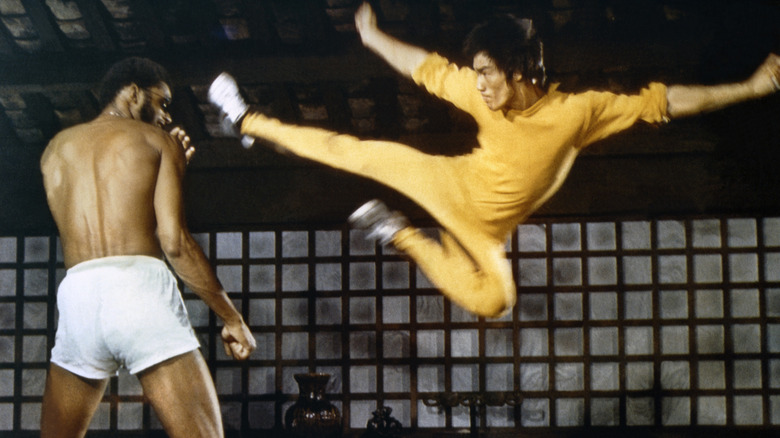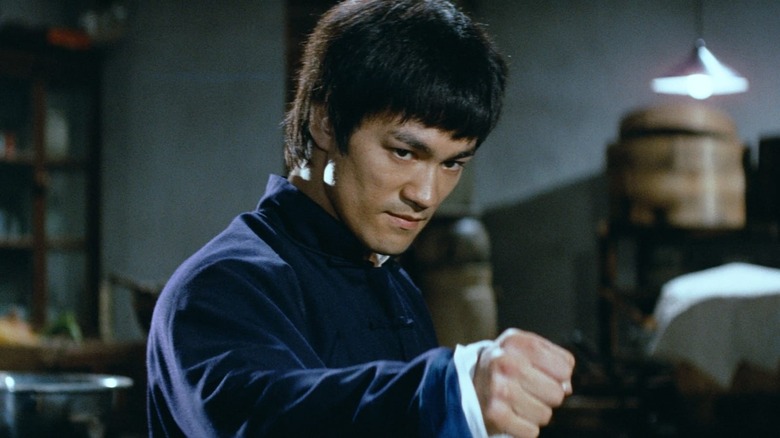
Sometime in the '90s -- I couldn't have been no more than 4 years old -- my big brother brought home this fighting game called "Mortal Kombat" for the Sega Genesis. My favorite character quickly became Liu Kang. In my young, impressionable eyes, the character's martial arts moveset and his high-pitched "Whaaaaah!" and "Wha-taaaah!" every time he connected on one of his flying kicks made him way cooler than the rest of the playable characters. I put to memory the controls to executing one of those flying kicks and obnoxiously repeated the move over and over again until I reached the point where no one wanted to play against me.
That video game character was my introduction to the martial arts movie star and pop culture icon Bruce Lee. The legendary figure was so iconic by the time I entered the world that his image and likeness were serving as inspiration for the creation of a number of video game characters, and Lui Kang was just one of many (Marshall Law from "Tekken'' became another one of my favorites). In my adulthood Bruce Lee remained a mythical figure, the personification of martial arts with his high-pitched kiai, white wife beater underneath the traditional navy-blue tunic, and matching trousers.
I didn't begin to understand the human behind the myth until I watched ESPN's 2020 documentary "Be Water." The film's director, Bao Nguyen, made a concerted effort to humanize Lee. "I wanted to do the film because Bruce Lee is a cultural icon, a global figure," Nguyen told The Film Experience in 2021. "But because he's those things, people don't really see him as a person, or as a human being."
Controversy Surrounding Who Bruce Lee Really Was

Before ESPN's released "Be Water" as a part of the network's "30 for 30" series, Bruce Lee's personality had become a hot topic for debate. Let some tell it, the "Fist of Fury'' star was an arrogant, ethnocentric person who looked down on white Americans. In an interview with Cityonfire.com, American karateka and kickboxer Joe Lewis (not the boxer) said Lee originally asked him to play the antagonist and world-class fighter Colt in 1972's "Way of the Dragon." Lewis, who is white, said he turned down the role that would later be given to an unknown Chuck Norris because Lee had specific intentions for his inclusion in the film. He explained:
"[Bruce Lee] used to tell me his agenda when we were training about how he wanted to show the world that the Oriental was the superior fighter. He always used the term 'by beating the Caucasian,' and asked if I wanted to be in a movie with him. I said no then, as I did later on for "The Way of the Dragon." He then would laugh and say he'd get Chuck [Norris] instead and how he'd enjoy beating the hell out of him."
Quentin Tarantino's Portrayal Of Bruce Lee Draws Backlash

Director Quentin Tarantino depicted Bruce Lee in an unflattering light in his 2019 comedy-drama film "Once Upon a Time in Hollywood." In a cameo, Lee (portrayed by Mike Moh) delivers an overbearing speech on the set of the TV series "The Green Hornet." He says he would cripple Muhammad Ali if the two icons ever fought, then proceeded to challenge an American stuntman, Cliff Booth (Brad Pitt) to a fight. Booth ends up throwing Lee back-first into a car in embarrassing fashion.
Tarantino received backlash for this depiction, but the director defended his portrayal in an interview on Joe Rogan's podcast, saying Lee had nothing but disrespect for American stuntmen. "He was always hitting them with his feet; he was always tagging -- it's called tagging when you hit a stuntman for real," the director explained. "And he was always tagging them with his fist." Tarantino said it had gotten to a point where stuntmen refused to work with the actor.
Shannon Lee, Bruce Lee's daughter, wrote a guest column for The Hollywood Reporter blasting Tarantino, writing that she was "really f****ing tired of white men in Hollywood trying to tell me who Bruce Lee was." She added: "I'm tired of hearing from white men in Hollywood that he was arrogant and an a**hole when they have no idea and cannot fathom what it might have taken to get work in 1960s and '70s Hollywood as a Chinese man with (God forbid) an accent, or to try to express an opinion on a set as a perceived foreigner and person of color."
In "Be Water," Bao Nguyen, a Vietnamese-American, bridges the disconnect between who Bruce Lee was and how he was perceived, especially by Hollywood.
Bruce Lee Had A Tough Time Breaking Into Hollywood

"Be Water" dives into Bruce Lee's upbringing. He was born in San Francisco, California but spent his childhood in Hong Kong. He took up martial arts at age 13 for self-defense after a group of boys jumped him at school. By 18, he was in so much trouble in Hong Kong that his family decided he needed a fresh start and sent him packing to Seattle, Washington with $100 in his pocket. Determined to succeed without his father's money, Lee worked as a waiter while attending school and working to start his own martial arts practice.
He struggled to find his way in a predominantly white country, so much so that he tried to mask his accent. He detested the harmful Asian stereotypes in American films. The 1961 romance comedy "Breakfast at Tiffany's" especially offended him. When he tried to break into Hollywood, he resisted any role he saw demeaning to his heritage and culture. He landed the role of Kato in "The Green Hornet" and had to fight for speaking lines. Eventually, he resorted to creating his own roles.
In an industry where Asian characters received the short end of the stick, Lee wanted to balance the scale and make films in which an Asian protagonist came out on top. His yearning for cultural respect explains his perceived cocky demeanor and desire to cast Joe Lewis and Chuck Norris as the villain and beat them in "The Way of the Dragon." Bao Nguyen made sure he highlighted Lee's struggles.
"Because he faced a lot of challenges, a lot of obstacles, being an Asian in America at that time," Nguyen told JumpCut Online in 2021. "I wanted to present those challenges to an audience that maybe didn't know about them."
Read this next: The 50 Best Documentaries You Can Watch On Netflix Right Now (July 2022)
The post How ESPN's Be Water Tried to Bring Humanity Back to the Mythic Bruce Lee appeared first on /Film.
